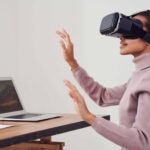Backcasting for startups, a strategic bridge from the future to the present
We cannot confidently predict the future, but we can build it. Future studies or research in futurology are one of the best tools to guide our personal projects and wishes, as well as to design the strategy for the coming years of our company or startup and therefore succeed with innovation.

Could we have predicted the pandemic? Could a company have had an innovative strategy ready for it? Can startups anticipate future market demands and how they will change?
Imagining our future according to our objectives is something we all do, and this includes companies, but how can we know what steps will take us into a tomorrow as close as possible to what we want? Futurology has been an established academic discipline since the 1970s. It has nothing to do with astrology or crystal balls, but instead features the systematic analysis of possible, probable and preferable futures, from a sceptical and divergent point of view. Exploring them can be a real challenge - as our object of study has not yet happened, we do not have historical documents or archaeological remains.
"The future is created by all of us and we should invest in trying to project different possibilities"
Backcasting, or a retrospective from the future, is the technique that lets us "leave a trail of breadcrumbs" from that desired scenario that we mentally envisage up to the present time, with the idea that it potentially ends up happening. And sometimes traditional planning, which is part of the present moment, limits us and stops us from exploring new alternatives. Let's look at how to open our eyes to the future, especially to better guide our business, spot opportunities and be innovative.
Designing scenarios
To begin backcasting, whether in a personal or business environment, we should follow these steps:
- Visualise the desired scenario in your mind.
- Come back from that vision to the present.
- Move step-by-step towards it.
This may sound too general, so let's try to go into the specifics. The philosopher and co-founder of The Futures Factory, Isabel Fernández Peñuelas, who took part in the BBVA Open Talks online event about backcasting on 7 July, points out that, unlike design thinking, which is more focused on the short or medium term, designing futures is about looking ahead to the long term. "Design thinking seeks to create a solution for today's problem, while futures design seeks to find the possible problems and solutions of tomorrow," she explains.

But how can we study the future if we can't use an empirical method? Fernández Peñuelas explains that it's important to be able to link the desired vision to a strategy and states that, to navigate the uncertainty of the possible scenarios, the following techniques are often used.
- The futures cone, which allows you to locate and differentiate probable, plausible and possible futures.
- Scenario analysis, a matrix that crosses different possibilities on two axes of uncertainty.
- 'S' curves, highly relevant at the quantitative level, the ultimate goal of which is to determine the moment at which a certain trend is constituted.
- Prediction markets, which are based on pooled intelligence to place bets on future events.
- Predictive narratives such as causal layered analysis, a tool within the prospective narrative, which makes it possible to analyse the root causes of why we have a certain vision of the future, analysing which metaphors and world views support it.
Future or futures? Look out for the signs
If the range of possibilities is so wide, can we speak of the future as a single thing? Innovation Director of Innuba, David Alayón, who also participated in the BBVA Open Talks event, suggests that we talk about futures rather than the future - when used in the singular, the term acquires deterministic connotations, while in the plural it opens the door to different possibilities.
As a result, although we do not know for certain what those futures will be, we can anticipate different scenarios and have a more open outlook. "We shouldn't think that the future is something unique that we have to guess at, in fact it's quite the opposite - the future is created by all of us and we should invest in trying to project different possibilities", Alayón insists. Once we have the different scenarios in mind, we have to assess which ones we would like to be viable or preferable, and act accordingly so that they become reality.
"Backcasting is also ideal to support innovation, as it can improve the search for opportunities"
Alayón adds that there are many ways to anticipate these futures and that we have more and more data to help us do so. Big data has also reached the future, and he explains that there are two different sets of data to which we need to pay attention.
- The signs of change. These are signs that give us clues that something is changing now and could therefore change in the future. Many of them are powered by technology, whilst others are not, such as social or demographic changes. During the BBVA Open Talks session, Alayón wondered whether we could have anticipated the pandemic, seen as "we had seen several signs of change such as the case of other SARS viruses".
- Trends. These come from projecting a set of signs of change into the future and you have to give them a direction vector, meaning that you predict how a specific element is going to behave - whether it will increase or decrease, for example. One of the current trends is megacities, which attempt to bring together a large population and numerous services in neuralgic centres, and there are future projections that these will be found mainly in Asia and Africa.

This type of data-based approach is often adopted in the environmental sphere, as it is a field with a high scientific and data component. Alayón provides as an example the forecasts that are usually made about global warming. However, he adds, in social contexts it is more difficult to carry out this series of predictions. So what happens if we apply it to a business context?
Strategic forecasts for startups
In the specific case of startups and companies, backcasting is an effective method for exploring possible futures in strategic decision-making. For instance, an entrepreneur or businessperson might wonder how a particular business environment would look if there was a radical change to certain aspects, like what the technology of tomorrow will be like or what a customer's needs will be, says an article by the School of Business Transformation (ESTREM).
The philosopher and co-founder of The Futures Factory explains that "a startup has to know where it is going, and future studies deal with precisely that". Consequently, if companies do not carry out an anticipation exercise, they will not be successful with the innovations they propose. In addition, analysing signs of change is essential for risk assessments in entrepreneurial processes. "Sometimes the pressure to achieve a return on investment forces people to focus too much on the short to medium term. We need to focus on achieving results but always with a long-term strategy," she indicates.
"A startup has to know where it is going, and future studies deal with precisely that"
On the other hand, for David Alayón, the technique of backcasting is ideal for companies and startups, because when different scenarios are projected, detailed reports are usually produced that can spot potential strengths or weaknesses, but without giving rise to a comprehensive roadmap that takes these into account (something that is done with futurology). "This is where backcasting comes into play, as it allows us to go far beyond simply releasing a report, providing us with that roadmap and setting different milestones that really take us where we want to go," he explains. As a result, backcasting is also ideal to support innovation, as it can improve the search for opportunities and, above all, the likelihood of making that future vision tangible through plans and projects.
We all look to the future, but each of us has a different strategy - some people and companies use backcasting to try to avoid undesirable futures, reducing risks. Others rely on it to work proactively on creating the desired scenarios. In the end, in all future scenarios you have to keep one eye on innovation and, as Alayón says, "it's about thinking big, starting small and moving fast".